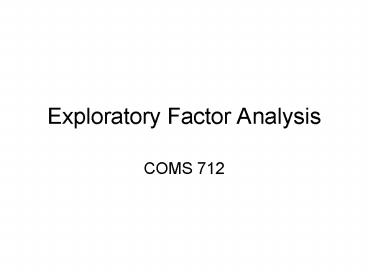Exploratory Factor Analysis - PowerPoint PPT Presentation
1 / 13
Title:
Exploratory Factor Analysis
Description:
The Scree Test is a visual method of identifying factors ... Scree Plot for Data. How Many Factors to Retain ... but also provides a scree plot for inspection. ... – PowerPoint PPT presentation
Number of Views:413
Avg rating:3.0/5.0
Title: Exploratory Factor Analysis
1
Exploratory Factor Analysis
- COMS 712
2
Objectives for Tonight
- Learn about Exploratory Factor Analysis (EFA)
- Discuss the following articles
- Thoman, Palmer, Coker-Juneau Williams
- Levine McCroskey
- Go to the Lab
3
Exploratory Factor Analysis
- What is it?
- When do you use it?
- Key Questions you are trying to answer
- What are the procedures for doing an EFA?
- How many factors should I retain?
- How do I know which items to include on which
factors? - What are some limitations and data considerations
relevant to EFA?
4
When should you use EFA
- Determine how to reduce the number of variables
(data reduction). - Increase the parsimony of analyses.
- Reduce the number of analyses performed (hence, ?
the Type I error). - Reduce the potential of multicolinearity in
regression equations.
5
Procedures for EFA
- Select variables
- Perform Sphericity test
- Identify criteria for factor extraction
- Identify rotation method
- Perform analysis and interpret results
- Compute factors, calculate reliability, and
perform primary analyses
6
How Many Factors to Retain
- The most widely used criterion is Kaisers (1960)
Eigenvalue test - Retain all factors with Eigenvalues gt 1
- Most robust when the number of variables is small
(10-15) or moderate (20-30). - The Scree Test is a visual method of identifying
factors - Retain all factors before the line flattens out
- Retain all factors until a minimum threshold of
variance accounted for is achieved.
7
Scree Plot for Data
8
How Many Factors to Retain
- SPSS uses the Kaiser Eigenvalue criterion by
default, but also provides a scree plot for
inspection. - If your data meets the following characteristics
there is no reason to avoid the Kaiser criterion - Number of variables lt 30 and Communalities are gt
.70 - N gt 250 and Mean Communality is gt .60.
- Your factors should account for a meaningful
amount of variance.
9
Which Items to Include?
- The factor analysis components are artificial
derivates and are impossible to use when
interpreting factor structure. - Rotation methods are used to make factor
structures more clear. - Orthogonal Rotation Factors uncorrelated
- Oblique Rotation Factors correlated
10
Which Items to Include
- The Orthogonal rotation method is easier to
interpret. By default SPSS uses the cleanest
of the methods Varimax. - Oblique rotation is more difficult to interpret
and you have more options Promax, oblimin,
oblimax and others. - Try both and see what happens.
11
Which Items to Include
- You use rotated factor scores to place items
- 70/30 Criterion
- 60/40 criterion
- Items should not load on more than one factor.
- Unless your sample is gt 500 all factors should
have at least 1/5 of the items.
12
?
?
?
?
?
?
?
?
?
?
?
?
?
?
?
?
?
?
?
13
Limitations and Data Considerations
- Factor structures are unstable in small samples.
- The assumption of uncorrelated factors is rarely
present. - Reliability coefficients and correlations must be
analyzed. Retain only one score if both
conditions are true - Reliability for the factors is weaker than the
overall scale. - Correlations between factors are large































